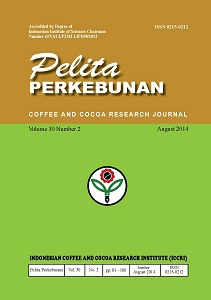A Study of Allelopathy of Some Shade Trees to Coffea arabicaL. Seedlings

Article Sidebar

PDF

Published
May 1, 2006
DIMENSION
ALTMETRIC
Main Article Content
Adi Prawoto
Indonesian Coffee and Cocoa Research Institute
Abstract
Because of social economic judgment, many coffee planters nowadays grow Cassia spectabilisand in the certain regions used Cinnamomum burmani, Macadamia integrifolia, Tectona grandisand Cassia siameaas shade trees or intercrops. Before being used in large scale, allelopathy study is appropriate to be done because this effect is much more difficult to be overcome than competiton as growing factor. Research on allelopathy of those species had been conducted in glasshouse of Indonesian Coffee and Cocoa Research Institute using Salisbury & Ross method. Leachate of Cassia spectabilis Cinnamomum burmani, Macadamia integrifolia, Tectona grandisand Cassia siamea, pure media (without plant) and control (well water) were used as treatments. Planting material of Cinnamomum burmani, Macadamia integrifolia, Tectona grandisand Cassia siameawere as seedlings of one year old, whereas C. spectabiliswas 3 months old. Those materials were planted in polybags 20 cm x 30 cm and replicated five times. The media was a mixture of top soil, manure and sand 1 : 1 : 1 (v/v). After those species were maintained for one months and Arabica seedlings for three month old, watering of coffee seedlings then using leachate from shade trees media. Every two days, each seedling was applied with 200 ml. Control was applied with well water. Pure media was used to study the effect of nutrient supply contained in the leachate. The experiment was stopped at seven month old of the coffee seedlings. The result showed that C. spectabilisreleased chemicals which showed allelopathic effect to Arabica coffee, their growth was inhibited 10% to control. The growth decreament from Cassia siameaand D. zibethinustreatment mainly caused by lower mineral content in the leachate and indicated by weak allelopathic. On the other hand M. integrifoliaand C. burmanidid not show allelopathic to Arabica coffee. Thus, based on allelopathy aspect, it can be included that C. spectabilisand C. siamea were not recommended as shade trees or intercrops with Arabica coffee and for D. zibethinusits cropping pattern must be arranged so the mineral competition could be maintained minimum. Key words: Allelopathy, Coffea arabica, Macadamia integrifolia, Cinnamomum burmani, Cassia siamea, Cassia spectabilis, mineral.
Article Details
How to Cite
Issue
Section
Articles

This work is licensed under a Creative Commons Attribution-NonCommercial 4.0 International License.
Authors who publish with this journal agree to the following terms:
- Authors retain copyright and grant the journal right of first publication with the work simultaneously licensed under a Creative Commons Attribution License that allows others to share the work with an acknowledgement of the work's authorship and initial publication in this journal.
- Authors are able to enter into separate, additional contractual arrangements for the non-exclusive distribution of the journal's published version of the work (e.g., post it to an institutional repository or publish it in a book), with an acknowledgement of its initial publication in this journal.
- Authors are permitted and encouraged to post their work online (e.g., in institutional repositories or on their website) prior to and during the submission process, as it can lead to productive exchanges, as well as earlier and greater citation of published work (See The Effect of Open Access).
Most read articles by the same author(s)
- Adi Prawoto, Pattern of Flushing, Cherelle Wilt, and Accuracy of Yield Forecasting of Some Cocoa Clones , Pelita Perkebunan (a Coffee and Cocoa Research Journal): Vol 30 No 2 (2014)
- Adi Prawoto, M Sholeh N.P, Early Yield and Economical Study of Pogostemon Cablinas Intercrop in Young Cocoa (Theobroma cacaoL.) , Pelita Perkebunan (a Coffee and Cocoa Research Journal): Vol 22 No 3 (2006)
- Oscar Regazzoni, Yogi Sugito, Agus Suryanto, Adi Prawoto, Physiological Character of Cocoa Clones that Cultivated under Three Species of Shade Trees , Pelita Perkebunan (a Coffee and Cocoa Research Journal): Vol 30 No 3 (2014)
- Oscar Regazzoni, Yogi Sugito, Agus Suryanto, adi prawoto, Solar Energy Efficiency of Cocoa Clones which Cultivated under Three Species of Shade Trees , Pelita Perkebunan (a Coffee and Cocoa Research Journal): Vol 31 No 1 (2015)
- Adi Prawoto, Coffee Yield and Mineral Cycle in Intercropping of Coffea canephora and Some Species of Timber Shade Trees , Pelita Perkebunan (a Coffee and Cocoa Research Journal): Vol 24 No 1 (2008)
- Rudy Erwiyo, Adi Prawoto, Soil Nutrient Condition of Coffee Cultivation with Industrial Woody-crops , Pelita Perkebunan (a Coffee and Cocoa Research Journal): Vol 24 No 1 (2008)
- Ketut Anom Wijaya, Adi Prawoto, Syrril Ihromi, Induction of Cocoa Natural Resistancy to Cocoa Pod Borer by Silica Application , Pelita Perkebunan (a Coffee and Cocoa Research Journal): Vol 25 No 3 (2009)
- Adi Prawoto, Nurul Qomariyah, Sri Rahayu, Bambang Kusmanadhi, (Agronomical and anatomical study of resulted early cocoa (Theobroma cacao L.) grafting , Pelita Perkebunan (a Coffee and Cocoa Research Journal): Vol 21 No 1 (2005)
- Fitria Yuliasmara, Aris Wibawa, Adi Prawoto, Carbon stock in different ages and plantation systemof cocoa: allometric approach , Pelita Perkebunan (a Coffee and Cocoa Research Journal): Vol 25 No 2 (2009)
- Fitria Yuliasmara, Aris Wibawa, Adi Prawoto, Carbon stock in different ages and plantation system of cocoa: allometric approach , Pelita Perkebunan (a Coffee and Cocoa Research Journal): Vol 26 No 3 (2010)
